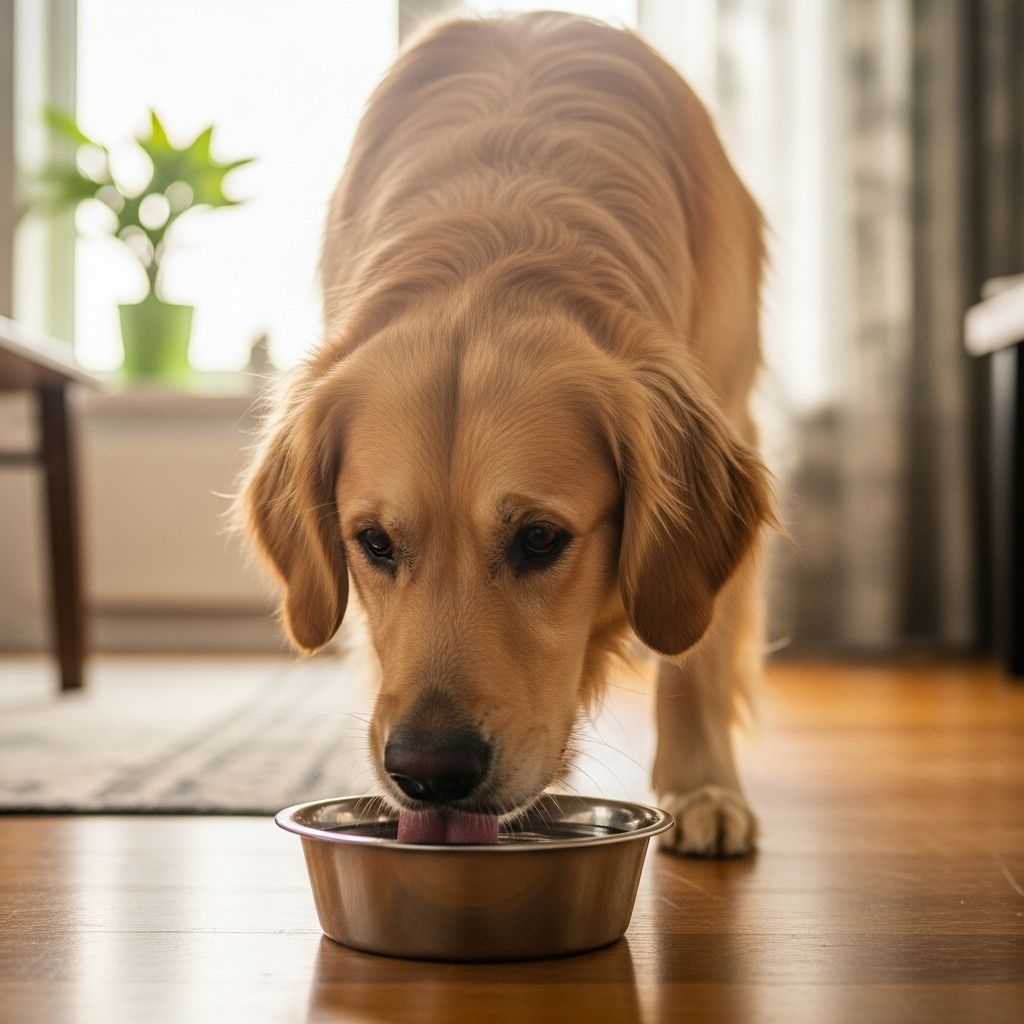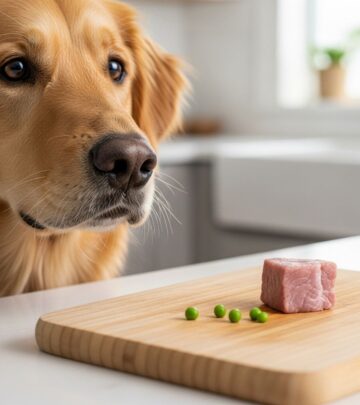Why Is My Dog Drinking a Lot of Water? Understanding Causes and Next Steps
Learn why your dog might be drinking more water than usual, what it could mean for their health, and what actions you should take.

Why Is My Dog Drinking a Lot of Water?
Many dog owners notice their pets visiting the water bowl more frequently and wonder if this is normal or a sign of an underlying problem. Increased water intake in dogs can result from various factors, ranging from harmless causes like exercise and weather to serious illnesses that require veterinary attention. Understanding what triggers excessive thirst, known as polydipsia, and knowing when to take action can help keep your dog healthy and safe.
Key Takeaways
- There are many underlying factors behind excessive thirst in dogs, including diet, activity, medications, and medical conditions.
- Polydipsia can be a sign of health issues such as kidney disease, diabetes, or Cushing’s disease.
- Access to fresh water is always essential; never restrict your dog’s water unless explicitly directed by a veterinarian.
- Early detection and diagnosis can make treatment of underlying conditions simpler and more successful.
How Much Water Should a Dog Drink Daily?
The general guideline is that a healthy dog should drink about 1 ounce of water per pound of body weight per day (e.g., a 10-pound dog needs about 10 ounces or just over a cup daily). However, individual needs may vary based on several factors, including:
- Puppies, nursing dogs, and very active dogs may require more water.
- Dogs in warm climates often need increased intake to compensate for heat and potential dehydration.
- Dogs fed canned or high-moisture foods may drink less from their bowl.
Important: Never deprive your dog of water, even if you notice them drinking more, unless specifically instructed by your vet. Water deprivation can rapidly cause dehydration, electrolyte imbalances, and potentially severe consequences.
How to Tell If Your Dog Is Drinking Too Much Water
To accurately spot abnormal drinking habits, it’s crucial to observe your dog’s typical water intake over several days and note any sudden or sustained change. Signs of excessive thirst include:
- Needing to refill the water bowl more frequently
- Your dog seeking out non-traditional sources of water (toilets, puddles)
- Increased urination, accidents in the house, or needing to go outside more often
Veterinarians define polydipsia as water intake that is twice the normal maintenance requirement, generally over 100 ml/kg body weight per day.
Dehydration Test at Home
The ‘tenting test’ is a quick way to check hydration:
- Gently pinch the skin over your dog’s shoulder blades or on their side.
- If the skin springs back quickly, your dog is likely well-hydrated.
- If it returns slowly, your dog may be dehydrated and in need of fluids.
Other signs of dehydration include dry, sticky, or pale gums.
Why Is My Dog Drinking So Much Water? Common and Medical Causes
Numerous factors—both benign and serious—can drive increased thirst. Recognizing these helps you and your veterinarian accurately identify the cause.
Common Non-Medical Causes
- Exercise and Activity: Dogs use more water to cool themselves after exertion or play.
- Hot Weather: Heat and humidity increase the risk of dehydration, just as with people.
- Dietary Factors: Dogs that eat dry kibble may need to drink more than those on canned or fresh diets rich in moisture. Salty or high-sodium treats can also trigger thirst.
- Medications: Some drugs (particularly corticosteroids or certain diuretics) have increased drinking and urination as a side effect.
- Behavioral Factors: Some dogs (typically younger or bored dogs) develop an excessive drinking habit out of attention-seeking or boredom—often called psychogenic polydipsia.
Medical Causes of Excessive Drinking in Dogs
| Condition | Description | Common Signs |
|---|---|---|
| Kidney Disease | Impaired kidney function leads to increased urination and compensatory thirst. | Weight loss, vomiting, lethargy, bad breath, pale gums, loss of appetite. |
| Diabetes Mellitus | High glucose levels cause sugar and water loss in urine. | Increased urination, increased appetite, weight loss. |
| Cushing’s Disease (Hyperadrenocorticism) | Overproduction of cortisol hormone in the adrenal gland. | Increased thirst, panting, hair loss, pot-belly, skin changes. |
| Urinary Tract Infection (UTI) | Frequent urination with thirst as a compensatory mechanism. | Straining to urinate, accidents, blood in urine, frequent licking. |
| Liver Disease | Affects the body’s metabolism and hydration balance. | Jaundice, vomiting, confusion, loss of appetite. |
| Medications | Corticosteroids, anti-seizure, or certain heart drugs, among others. | Varies, but increased drinking and urination common. |
| Psychogenic (Behavioral) Polydipsia | Excessive drinking without physical cause; often anxiety- or boredom-driven. | Otherwise healthy; diagnosis by exclusion. |
Less Common Causes
- Primary Polydipsia: Some dogs simply love water, especially retrievers or water breeds.
- Hypercalcemia: High calcium, sometimes due to cancer, can increase thirst.
- Electrolyte Imbalances: Conditions causing sodium loss can affect water balance.
Why Do Senior Dogs Drink More Water?
Aging dogs often experience physiological changes that may increase their thirst, including:
- Reduced kidney function or age-related metabolic shifts
- Increased risk of diabetes, Cushing’s disease, or cancer
- Medication use and chronic health conditions
While some increase in thirst is normal with age, a sudden or dramatic change should always prompt a vet visit.
Can Dogs Drink Too Much Water?
While access to fresh water is always vital, drinking excessively can, in rare cases, lead to a dangerous condition known as water intoxication or hyponatremia. Overhydration causes sodium levels to drop dangerously, leading to swelling in cells—including the brain—and potential organ damage. This risk is greatest in small dogs or those that ingest large quantities of water rapidly (such as after playing with hoses, swimming, or during hot weather). Symptoms of water intoxication can include:
- Lethargy, bloating, nausea, vomiting
- Lack of coordination, staggered movements
- Dilated pupils, pale gums
- Collapse, seizures, or coma in severe cases
If you suspect your dog is drinking overly large volumes in a short time, especially after swimming or intense activity, contact your veterinarian immediately.
When Should I Worry and Seek Veterinary Help?
You should contact your veterinarian if you notice any of these warning signs along with increased thirst:
- Sudden or unexplained increase in water consumption (lasting more than 48 hours)
- Excessive urination, including accidents in the house
- Weight loss, decreased appetite, vomiting, or diarrhea
- Lethargy, behavioral changes, or signs of confusion
- Visible blood in urine or straining to urinate
- Signs of pain (whining, restlessness, odd posture)
Your vet will likely ask about the exact amount of water consumed per day, other symptoms, duration of the change, dietary patterns, and current medications.
What to Expect at the Vet
A veterinary diagnosis typically begins with a thorough physical exam and review of your dog’s medical history, followed by:
- Blood and urine tests to evaluate organ function and rule out diabetes, infections, or kidney issues
- Hormone tests if Cushing’s disease or hypothyroidism is suspected
- Potential imaging (ultrasound, x-ray) to check for tumors or abnormalities
Your vet may also request that you measure your dog’s daily water intake by keeping bowls filled to specific levels and recording consumption over a few days.
Should I Ever Limit My Dog’s Water?
No. Never restrict your dog’s water unless you have explicit instructions from your veterinarian. Depriving your dog of water can rapidly cause dehydration, kidney damage, or exacerbate underlying illness. The only exception is during specific diagnostic tests (like the water deprivation test for diabetes insipidus), always under direct veterinary supervision.
How to Safely Monitor and Support Your Dog’s Hydration
- Always provide access to clean, fresh water, including overnight.
- Wash water bowls daily to prevent bacteria growth.
- Bring portable water and a bowl on walks or outings, especially in hot weather.
- If concerned, measure your dog’s water intake for several days—note volumes and any related symptoms to share with your vet.
- Pay extra attention to senior dogs and dogs with a history of chronic illness.
Frequently Asked Questions (FAQs)
How can I tell if my dog is dehydrated?
Check for skin tenting (pinch and release the skin—it should spring back promptly), examine gums (should be pink and moist, not dry), and watch for lethargy or sunken eyes.
Is it normal for my dog to drink more after exercise?
Yes. Increased activity, excitement, or hot/humid weather often lead to harmless increases in thirst. However, persistent or excessive thirst warrants veterinary investigation.
Can a change in diet affect my dog’s water intake?
Absolutely. Dry kibble diets may increase thirst, while moisture-rich canned or fresh foods can reduce the need for extra water.
What medical tests can diagnose causes for increased water intake?
Blood tests, urinalysis, hormone panels, and imaging studies (such as ultrasound or x-ray) help identify most underlying causes, from kidney disease to hormonal disorders.
What happens if I ignore my dog’s increased thirst?
Ignoring persistent polydipsia may delay diagnosis of serious health problems, making treatment more difficult and potentially reducing your dog’s quality and length of life. Always err on the side of caution and speak to your veterinarian.
Summary Table: Signs & Causes of Increased Thirst in Dogs
| Symptom | Possible Cause | Is It an Emergency? |
|---|---|---|
| Short-term increased drinking after play | Normal | No |
| Drinking + increased urination | Kidney/liver disease, diabetes, Cushing’s disease | Contact vet |
| Drinking + vomiting/diarrhea | Acute illness, poisoning, dehydration | Contact vet promptly |
| Obsession with water, bloating | Possible water intoxication | Emergency |
| Drinking + lethargy/weight loss | Serious chronic disease | Contact vet |
Conclusion
Monitoring your dog’s water intake is a vital part of ensuring their overall health. A sudden or unexplained increase in thirst often indicates an underlying issue that, when caught early, can mean better outcomes through prompt veterinary care. Always provide fresh water, observe changes closely, and consult your veterinarian at the first sign of concern. Your attentiveness could make all the difference in your dog’s well-being and longevity.
Read full bio of Sneha Tete












